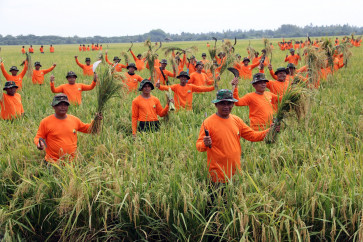Popular Reads
Top Results
Can't find what you're looking for?
View all search resultsPopular Reads
Top Results
Can't find what you're looking for?
View all search resultsHealth Sense: On managing arthritis and inflamed joints
If you wake up in the mornings with stiff and painful fingers, or feel pain in your joints when you work with your hands, you might have arthritis â a very common problem affecting the hand and wrist
Change text size
Gift Premium Articles
to Anyone
I
f you wake up in the mornings with stiff and painful fingers, or feel pain in your joints when you work with your hands, you might have arthritis ' a very common problem affecting the hand and wrist.
Joints allow you to move. The surface of each joint is covered in cartilage, which is smoother than any man-made material. Cartilage is also an effective shock absorber that prevents damage to the ends of bones when they press on each other during movement. A lubricating synovial fluid is produced by cells lining the joint. This nourishes the cartilage and makes joints even smoother.Joints are stabilized by strong ligaments that surround them.
Arthritis means joint inflammation, of which there are many different causes. The three most common types affecting the hands and wrists are osteoarthritis, rheumatoid arthritis and gout.
Osteoarthritis is the most common cause of joint pain in the hands and thumbs of older people and an inescapable fact of ageing. As we age, our ligaments become weaker and our joints less stable, resulting in abnormal distribution of tresses on the cartilage. Cartilage becomes more brittle and less effective at absorbing stress.
As we cannot avoid using our hands daily, all of us will have some osteoarthritis in our hands beyond our 50th birthdays. However, those who do heavy work with their hands and those with previous joint injuries may get it earlier.
Joints that develop osteoarthritis appear larger or deformed because of the abnormal bone alignment and growth of new bone to try and stabilize them. They also become stiffer, but usually retain enough movement for normal daily hand function.
The joints at the ends of our fingers and the base of the thumb are most commonly affected. The most important treatment is to modify the way one uses the hands to minimise stress on the affected joints. This decreases pain, and also decreases wear and tear.
Glucosamine and fish oil supplements may help strengthen cartilage. Pain is treated with simple pain killers like paracetamol and non-steroidal anti-inflammatory medication. Rest in a splint or a steroid injection to the joint may be needed.
In very severe cases where the joint is painful and unstable, surgery will help restore function. Depending on the joint involved and the severity of the arthritis, this is done by removing the joint and fixing the bones together (fusion) or by replacing the joint with an artificial one (arthroplasty).
Rheumatoid arthritis, meanwhile, is an an autoimmune disease, where the body produces abnormal antibodies that attack the lining of the joints and tendons all over the body. If left untreated, the joints and tendons are progressively destroyed, resulting in severe deformities of the hands. Knees, hips, shoulders and elbows are also affected, as are the joints in the spine.
This usually starts in the twenties or thirties, but may appear in the early teens or later in life. It is usually inherited genetically.
In the early stages morning stiffness, swelling and pain affects mainly the small joints of the hands and feet. If these symptoms are present in more than two joints for more than an hour every morning for more than six weeks, you should see a doctor to get a blood test done to check for rheumatoid arthritis.
Rheumatoid arthritis requires long-term treatment with medication to suppress the abnormal immune response and regular follow up with a rheumatologist to fine tune the treatment. With modern medication for rheumatoid arthritis, severe deformities of the hands are uncommon, and surgery is often avoided.
Surgery is needed if the deformities become severe enough to affect hand and wrist function. The type of surgery depends on the deformity and includes removal of excessive inflamed tissues to prevent tendon or joint destruction, repairs or reconstruction of destroyed tendons, joint replacement surgery and joint fusions.
Another common condition is gout, which affects many joints in the body, including the hands and wrists. This is caused by inability of the body to clear uric acid from the blood, resulting in a build up of abnormally large concentrations. Uric acid is found in food such as red meat, liver, intestines, dark green vegetables, seafood, soya bean products and red wines ' all of which should be avoided by someone with gout.
Uric acid gets into the lining of the joints and tendons, where it causes inflammation, usually after minor injury such as a knock or sprain, but sometimes without any injury. The inflamed joint becomes very hot, swollen, red and excruciatingly painful. Usually, only one or two joints are affected. The pain and swelling may be so severe that it requires hospitalisation for pain control and investigation for septic arthritis, which is a severe infection of the joint that needs urgent surgery.
A gout attack does not require surgery, and will settle on non-steroidal anti-inflammatory medication or oral steroids after one or two days. Uric acid can be controlled by avoiding the foods that contain it and by taking a medication called allopurinol.
Regular blood tests are needed to monitor the level of uric acid. If the amount of uric acid is not controlled, uric acid crystals will eventually accumulate in the joints and tendons as 'tophi'. These hard, ball-like structures restrict joint and tendon movements and can compress nerves causing numbness and pain.
They may become so large they stretch the skin until it breaks allowing germs to invade causing severe joint or tendon infections. Surgery is required to remove these tophi, release stuck joints, tendons or nerves and to clear infections.
________________
The writer obtained his medical degree from the Flinders University of South Australia, trained in surgery at Singapore General Hospital and National University Hospital and was accredited as a specialist in hand surgery. For more information, please visit charmssingapore.com.










